What Important Key SEO Terms Should Every Beginner Understand?
Introduction: What is SEO and Why It Matters?
Search Engine Optimization (SEO) is a dynamic and strategic process that aims to increase the visibility of a website on search engines like Google, Bing, and Yahoo. The more optimized your site is for search engines, the better your chances of ranking higher on search engine results pages (SERPs). SEO matters because it helps websites attract more visitors, generate leads, and convert those leads into paying customers. It can lead to significant business growth over time.
Understanding SEO means recognizing the importance of three primary elements: On-Page SEO, Off-Page SEO, and Technical SEO. Each component plays a critical role in ensuring your website performs well in search engines, and mastering them can help you build a robust SEO strategy. Below, we’ll discuss 30 key SEO terms every beginner should know across these three sections.
What On-Page SEO Terms Are Essential for Your Strategy?
1. Search Engine Optimization (SEO)
At its core, SEO involves optimizing your website to make it more accessible and relevant to search engines like Google. When search engines crawl through millions of web pages, they look for signals that indicate whether your site provides valuable content for users. These signals can be as varied as the structure of your website, the quality of its content, and even how fast it loads.
The practice of SEO involves various techniques: On-Page SEO, Off-Page SEO, and Technical SEO, and it spans many areas, such as keyword research, link building, and website optimization. By implementing good SEO practices, you increase your chances of attracting organic traffic—users who visit your website without paid advertisements. This traffic is highly valuable because it’s more likely to convert into sales or leads. SEO is an ongoing process, as search engines continually update their algorithms, meaning you need to stay updated on SEO trends and strategies.
Table of Contents

2. Keywords
A keyword is a word or phrase that describes the content on your page and helps search engines understand what your website is about. For example, if your site sells running shoes, relevant keywords could include “best running shoes,” “buy running shoes online,” or “running shoes for long-distance runners.” Keywords connect what users are searching for with the content you offer.
Choosing the right keywords for your SEO strategy is essential because they influence where your content appears in search results. Keyword research tools, such as Google Keyword Planner, help you identify popular search terms and assess their competitiveness. For effective SEO, your content should include primary keywords (those with high search volume) and long-tail keywords, which are more specific and less competitive.
3. Long-Tail Keywords
Long-tail keywords are highly specific keyword phrases consisting of three or more words. While they might attract less traffic than broader terms, they often yield higher conversion rates because they cater to users with clearer intent. For example, “best men’s running shoes for marathon” is a long-tail keyword that’s more targeted than a general term like “running shoes.”
Long-tail keywords are particularly useful for new websites that might struggle to compete with larger sites targeting popular terms. Since these keywords are more specific, there’s less competition, meaning it’s easier to rank for them. Additionally, long-tail keywords align closely with a user’s search intent, making them crucial for niche markets or specific product offerings.
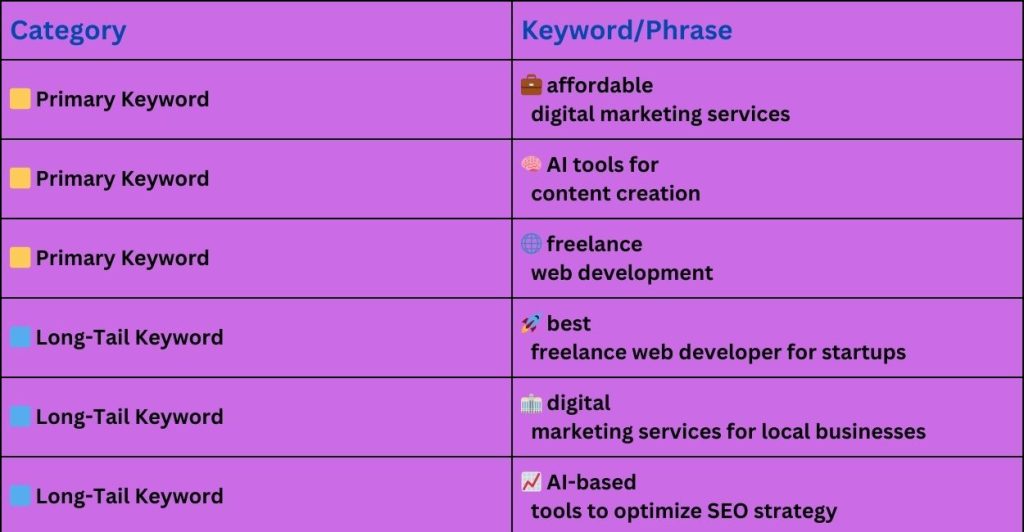
4. Keyword Density
Keyword density refers to how frequently a keyword shows up in content in relation to the overall word count, expressed as a percentage. For example, if a 1,000-word article mentions a target keyword 10 times, the keyword density is 1%. Maintaining an optimal keyword density is essential for effective SEO without compromising the quality of your content.
Search engines like Google are smart enough to detect overuse or “keyword stuffing”—a black-hat SEO practice where a page is filled with an excessive number of keywords. Overuse can result in penalties, while too little usage may make it harder for search engines to determine what your content is about. A good rule of thumb is to keep your keyword density between 1-2% and ensure keywords are used naturally within the context of the content.
5. Meta Descriptions
A meta description is a short paragraph (usually 150-160 characters) that provides a brief summary of a webpage’s content. Meta descriptions appear underneath your site’s link in search engine results pages (SERPs) and are intended to attract users to click on the link. Though not a direct ranking factor, meta descriptions are important because they can significantly improve your click-through rate (CTR).
For example, a compelling meta description for an article about running shoes might read: “Discover the top running shoes of 2024—comfortable, durable, and perfect for all types of runners. Shop now for the best deals!” Including a target keyword in the meta description can also increase the chances of the search term being bolded in the results, making it more visible to users.
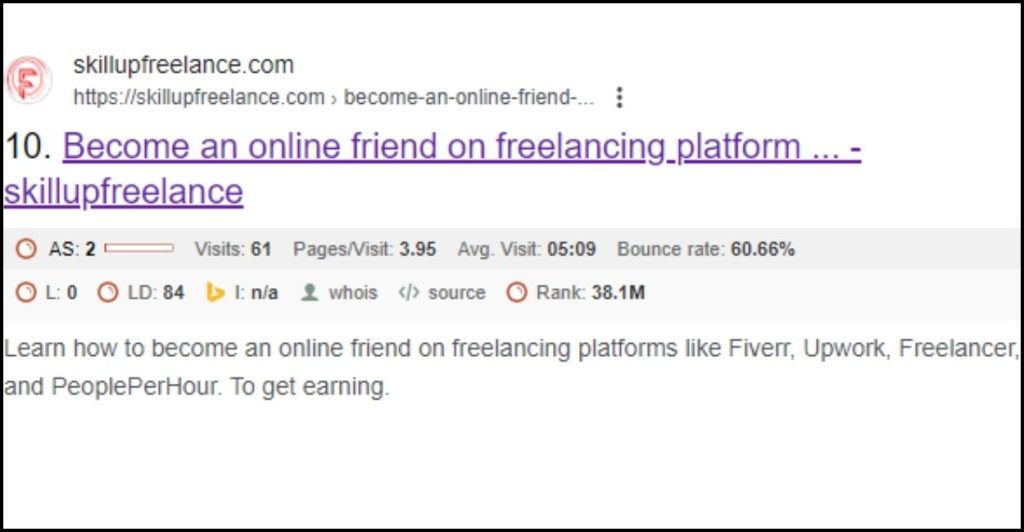
6. Internal Links
Internal linking is a critical On-Page SEO technique that involves linking one page of your website to another. It helps users navigate your site, keeps them engaged, and signals to search engines which pages are most important. For example, if you run a blog about SEO, you might link to another post within the blog that explains a related concept, such as keyword research.
Internal linking strengthens your website’s structure by creating a clear content hierarchy, which is beneficial for both search engines and users. Search engines rely on these links to discover new content and understand how different pages on your site are connected. Additionally, internal links distribute link equity or “link juice” across your website, helping boost the ranking potential of less prominent pages.
7. Landing Page
A landing page is a specific webpage that users are directed to after clicking on a link, whether from an ad, social media post, or email campaign. Landing pages are usually designed with a single goal in mind—whether that’s to collect leads, drive sales, or encourage visitors to sign up for a newsletter. They often contain strong calls to action (CTAs) to encourage users to take the desired action.
From an SEO perspective, landing pages should be highly optimized with targeted keywords, concise copy, and fast loading times to improve both search rankings and conversion rates. Well-optimized landing pages can drive significant traffic, especially when paired with a robust Pay-Per-Click (PPC) or Search Engine Marketing (SEM) campaign.
8. Image Alt-Tags
An image alt-tag (also known as an alt attribute or alt text) is used to describe the content of an image to search engines and screen readers. Search engines can’t “see” images, so alt-tags provide a text alternative that helps search engines understand the image’s context. For example, an image of a cake might have an alt-tag like “chocolate cake with strawberry toppings.”
Incorporating relevant keywords into your image alt-tags can improve your website’s SEO, as images may appear in Google Image search results. Additionally, alt-tags improve accessibility by helping visually impaired users who rely on screen readers to interpret your content. When writing alt-tags, aim for descriptions that are specific, relevant, and keyword-friendly.
| SEO On-Page Terms | SEO On-Page Terms |
|---|---|
| Title Tag | Content-Length |
| Header Tags | Page Load Speed |
| URL Structure | User Experience (UX) |
| Internal Linking | Mobile Responsiveness |
| Content Quality | Schema Markup |
Section 2: Which Off-Page SEO Concepts Will Elevate Your Online Presence?
9. Off-Page SEO
Off-Page SEO refers to the optimization strategies and actions taken outside your website to improve its rankings on search engines. While On-Page SEO focuses on optimizing your website content, Off-Page SEO emphasizes building trust, authority, and credibility through external signals, such as backlinks from other websites. It also encompasses social media marketing, influencer collaborations, and brand mentions.
A key part of Off-Page SEO is earning backlinks from authoritative websites. When other reputable sites link back to your content, it signals to search engines that your site is trustworthy and valuable. The quality and quantity of backlinks significantly impact your website’s domain authority, which in turn influences its ranking in search results.
10. Backlink
A backlink is a link that directs users from one website to a different site. When reputable websites link to your content, it signals to search engines that your website provides valuable information, which can help improve your search engine rankings. Backlinks are an essential part of Off-Page SEO and one of Google’s top-ranking factors.
Not all backlinks are created equal. Backlinks from high-authority sites (such as major news outlets, academic institutions, or industry leaders) are much more valuable than links from low-quality or spammy sites. Building high-quality backlinks requires creating valuable, shareable content that other websites will want to link to naturally.
11. Link Building
Link building involves the process of obtaining backlinks from other websites to your own, helping to improve your site’s authority and search engine ranking. It’s a fundamental aspect of Off-Page SEO because search engines view backlinks as votes of confidence in your site’s content. The more high-quality backlinks you have, the more likely you are to rank higher in search engine results.
There are several strategies for link building, including guest blogging, creating link bait (content designed to attract links), and reaching out to influencers or website owners for collaboration. While link building can significantly boost your SEO, it’s essential to focus on earning backlinks from relevant, high-authority sites rather than purchasing low-quality links, which can result in penalties from search engines.
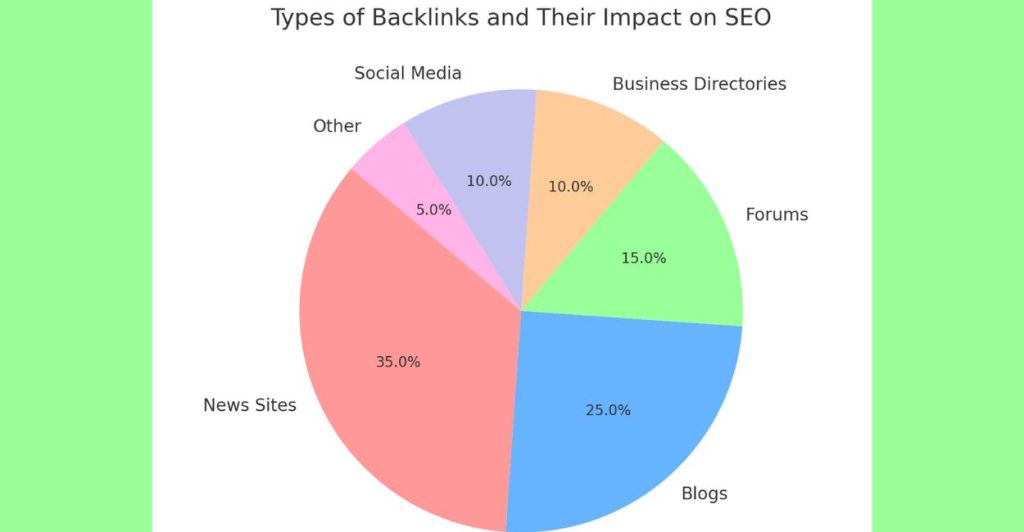
12. Link Bait
Link bait refers to content specifically created to attract backlinks. It is often highly informative, entertaining, or valuable, making it likely to be shared by other websites or social media platforms. Common forms of link bait include infographics, original research, in-depth guides, or viral content. When done well, link bait can lead to a significant increase in the number of backlinks, boosting your site’s authority and search rankings.
For example, if you create a comprehensive guide on the “Best SEO Tools of 2024,” it’s likely to attract links from blogs or websites that cover SEO topics. The key to successful link bait is providing unique, valuable, and shareable content that others will want to reference and link to.
13. Search Engine Marketing (SEM)
Search Engine Marketing (SEM) is a broader term that encompasses both SEO and paid search strategies like Pay-Per-Click (PPC) advertising. While SEO focuses on organic traffic, SEM includes paid efforts to increase your website’s visibility in search engine results. SEM campaigns typically involve bidding on keywords relevant to your business to have your ads appear at the top of search results.
SEM is effective for businesses looking for immediate visibility, especially when competing in highly competitive niches. Combining SEM with SEO allows you to build a strong presence in search results, driving both paid and organic traffic to your site. The ultimate goal of SEM is to drive conversions, whether that’s through lead generation, sales, or sign-ups.
14. Pay-Per-Click (PPC)
Pay-Per-Click (PPC) is a form of paid advertising where businesses bid on keywords to have their ads appear at the top of search engine results. As the term implies, you are only charged when a user clicks on your ad. PPC is an essential part of SEM and can provide immediate traffic to your website, complementing your organic SEO efforts.
PPC platforms, such as Google Ads, allow businesses to target specific keywords and demographics, giving them control over their budget and audience. While PPC can be expensive, it’s a highly effective way to drive targeted traffic and leads. A well-optimized PPC campaign focuses on high-performing keywords, creating compelling ad copy, and ensuring that the landing pages are optimized for conversions.
15. Local Pack
The local pack is a feature of Google’s search results that displays a set of local businesses relevant to a user’s query. For example, if you search for “best pizza places near me,” Google will display a local pack showing pizza places in your area. These listings appear at the top of the search results, often alongside a map, making them highly visible to users.
For businesses with a physical location, appearing in the local pack can drive significant traffic and footfall. Optimizing your Google My Business (GMB) profile is essential for local SEO, as GMB data is often used to populate the local pack. To improve your chances of being featured, ensure that your business name, address, and phone number (NAP) are consistent across the web, and encourage positive customer reviews.
16. Nofollow Link
A nofollow link is a hyperlink that includes a special tag
telling search engines not to pass on “link juice” or ranking power
to the linked website. In other words, the linked site won’t receive any SEO
benefit from the link. Nofollow links are often used in comments sections,
user-generated content, or paid advertising, where the site owner doesn’t want
to endorse the linked site.
While nofollow links don’t directly impact your SEO, they can still drive
valuable traffic to your website. Additionally, a natural backlink profile
should include a mix of dofollow and nofollow links, as too many dofollow links
from low-quality sources can raise red flags with search engines.
| Nofollow Links | Dofollow Links |
|---|---|
| Comment Sections | Blog Posts |
| User-Generated Content | Editorial Content |
| Social Media Profiles | Resource Pages |
| Paid Advertisements | Directory Listings |
| Forum Signatures | Guest Blog Posts |
17. Organic Traffic
Organic traffic refers to users who visit your website by clicking on unpaid search engine results, rather than through paid advertisements. It’s considered the most valuable type of traffic because these users are actively searching for information, products, or services related to your business. Organic traffic comes from implementing effective SEO strategies, such as keyword optimization, content creation, and link building.
The goal of any SEO campaign is to increase organic traffic over time. Unlike paid traffic, organic traffic is long-lasting and sustainable, providing consistent results even after the initial SEO work is done. Focusing on building organic traffic is crucial for long-term success in search engine rankings and user engagement.
| SEO Terms | SEO Terms |
|---|---|
| Domain Authority | Keyword Research |
| Click-Through Rate (CTR) | Site Map |
| Canonical URL | Robots.txt |
| Schema Markup | SEO Audit |
What Technical SEO Terms Should You Master for Better Performance?
18. Core Web Vitals
Core Web Vitals are a set of performance metrics that Google uses to evaluate the user experience on your website. These metrics consist of Largest Contentful Paint (LCP), First Input Delay (FID), and Cumulative Layout Shift (CLS). Core Web Vitals measure key aspects of how users interact with your website, such as how quickly it loads, how responsive it is, and whether the layout shifts unexpectedly.
Optimizing your Core Web Vitals is crucial for improving your site’s performance and search rankings. Google has made user experience a significant ranking factor, meaning sites that score well on Core Web Vitals are more likely to rank higher. To improve these metrics, focus on reducing page load times, minimizing delays in user interaction, and ensuring that your site’s layout remains stable as it loads.
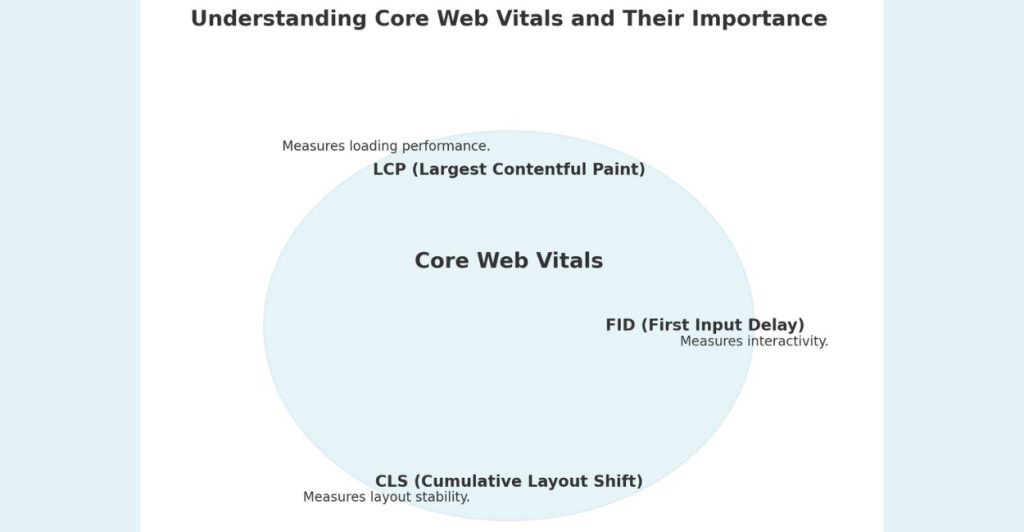
19. Crawlers
Crawlers often referred to as spiders or bots, are automated tools employed by search engines to navigate the internet and index web pages. These crawlers methodically visit websites, examine their content, and include them in the search engine’s index. When users conduct a search, the search engine retrieves relevant results from its index.
Making sure that your website is easy for crawlers to navigate is crucial for effective SEO. This involves optimizing your site’s structure, creating an XML sitemap, and avoiding technical issues that could prevent crawlers from accessing your content. Additionally, the robots.txt file on your website allows you to control which pages crawlers can and cannot access, helping to prioritize important content.
20. Featured Snippet
A featured snippet is a highlighted result that appears at the top of Google’s search results in a special box, often referred to as “position zero.” Featured snippets provide a quick answer to a user’s query and are typically extracted from one of the top-ranking pages. They can come in various formats, such as paragraphs, lists, or tables.
Appearing in a featured snippet can significantly increase your website’s visibility and drive more traffic. To optimize for featured snippets, focus on answering common questions clearly and concisely within your content. Structured data, such as schema markup, can also help Google identify and display your content as a featured snippet.
21. Schema Markup
Schema markup is a type of structured data that helps search engines understand the content on your website more effectively. By adding schema markup to your HTML code, you can provide additional context about your pages, such as the type of content (articles, recipes, reviews), the author, publication date, and more.
When search engines can better understand your content, they’re more likely to display rich results, such as rich snippets or knowledge panels, which can increase your visibility in search results. Adding schema markup is a powerful way to improve your SEO and enhance the user experience on your site.
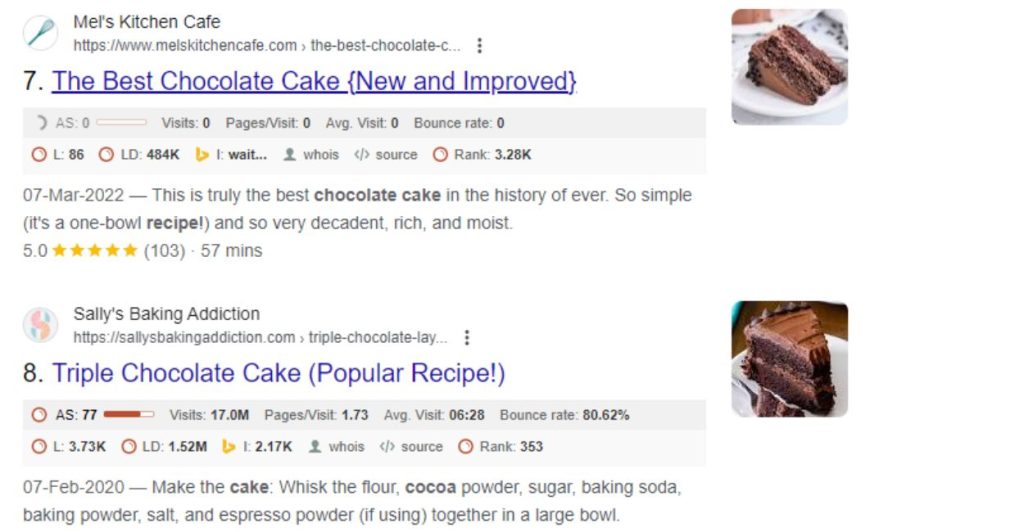
22. Canonical Tag
A canonical tag is an HTML element that helps prevent duplicate content issues by indicating the “canonical” or preferred version of a web page. Duplicate content can confuse search engines and harm your SEO, as they may not know which version of the page to rank. By using a canonical tag, you can tell search engines which page you want to be treated as the authoritative version.
For example, if you have multiple URLs with similar content (such as product pages with slight variations), a canonical tag ensures that search engines only index the main version. Proper use of canonical tags helps consolidate your ranking signals and prevent SEO penalties due to duplicate content.
23. XML Sitemap
An XML sitemap is a file that lists all the important pages on your website and provides information to search engines about how they should be crawled. Sitemaps help search engines discover and index your content more efficiently, especially if your website has a complex structure or many pages.
Submitting an XML sitemap to search engines like Google ensures that all your pages are indexed and included in search results. Sitemaps also provide metadata about each page, such as when it was last updated and how frequently it changes. Regularly updating your XML sitemap is essential for maintaining a well-optimized site.
24. Robots.txt
The robots.txt file is a text file on your website that tells search engine crawlers which pages they can and cannot access. This file helps you control how search engines interact with your site and prevent them from indexing certain pages that aren’t relevant to your SEO strategy, such as admin pages or duplicate content.
While blocking pages with robots.txt can help improve your site’s crawl efficiency, it’s important not to block pages that you want to rank in search results. Misconfiguring your robots.txt file can result in search engines missing important content, so it’s crucial to test your file regularly and ensure it’s set up correctly.
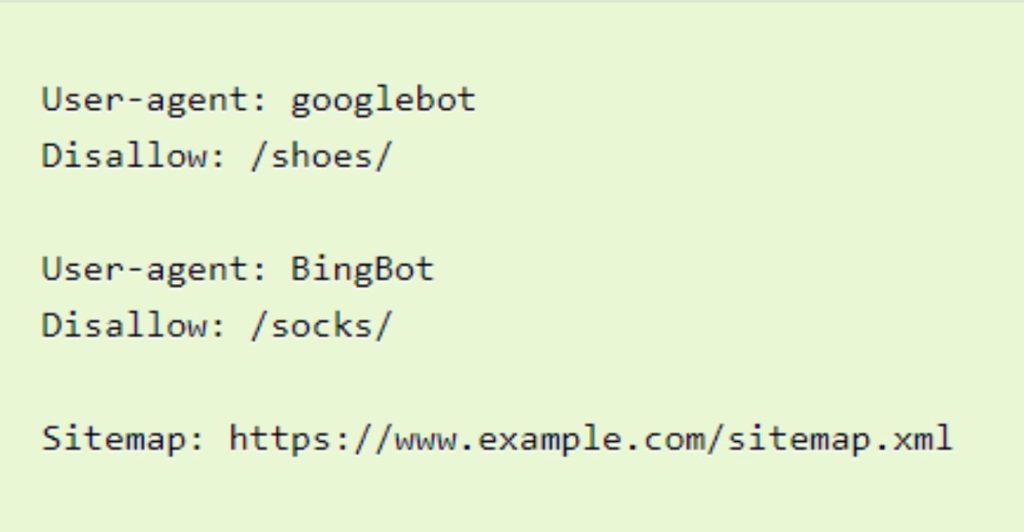
25. 301 Redirect
A 301 redirect permanently shifts traffic from one URL to another, ensuring both users and search engines follow the updated path. It’s used when a page has been moved or deleted, ensuring that visitors and search engines are redirected to the new page. A 301 redirect passes on the original page’s ranking power (or “link juice”) to the new page, preserving your SEO efforts.
Using 301 redirects is essential when restructuring your website, changing domain names, or merging content. Without a proper redirect, users may encounter 404 errors (page not found), which can harm your site’s user experience and search engine rankings. Regularly auditing and updating your redirects helps maintain a seamless user experience and prevents SEO issues.
26. 404 Error
A 404 error occurs when a webpage cannot be found. This can happen if the page has been deleted, the URL has changed, or there’s a broken link. While occasional 404 errors are normal, too many can hurt your website’s SEO and user experience, as search engines and users will be unable to access important content.
To minimize 404 errors, it’s important to regularly audit your site for broken links and set up 301 redirects for pages that have been removed or moved. Creating a custom 404 error page can also improve the user experience by providing helpful information and directing users to other relevant parts of your site.
27. HTTPS
HTTPS (Hypertext Transfer Protocol Secure) is an encrypted version of HTTP, which is used to transmit data between a user’s browser and your website. Websites with HTTPS have a secure connection, indicated by the padlock symbol in the browser’s address bar. Google has made HTTPS a ranking factor, meaning that secure websites are more likely to rank higher in search results than non-secure ones.
Enabling HTTPS is crucial for safeguarding sensitive user information, including login details and payment data, by ensuring encrypted and secure communication between the browser and server. To switch your site to HTTPS, you need an SSL certificate, which encrypts the data exchanged between the server and the user’s browser. HTTPS not only improves your site’s security but also enhances your SEO and user trust.
28. Mobile-Friendly Design
A mobile-friendly design refers to a website layout that adjusts and functions properly on mobile devices, such as smartphones and tablets. With more than half of all internet traffic coming from mobile devices, having a mobile-friendly site is essential for SEO and user experience.
Google uses mobile-first indexing, meaning it primarily evaluates the mobile version of your site for ranking purposes. To optimize for mobile, ensure that your site is responsive (adapts to different screen sizes), loads quickly, and provides easy navigation for mobile users. Testing your site’s mobile usability regularly can help you identify and fix any issues that may be affecting your search rankings.
29. Page Speed
Page speed refers to how quickly a webpage loads and is an important ranking factor for SEO. A fast-loading website provides a better user experience, reducing bounce rates and increasing the likelihood that users will engage with your content. Google uses page speed as a ranking signal, meaning slower websites may be penalized in search results.
Several factors can impact page speed, including large image files, excessive JavaScript, and server issues. Google’s PageSpeed Insights is a valuable tool for pinpointing performance bottlenecks and offering suggestions to enhance your site’s speed and user experience. Optimizing your page speed involves compressing images, reducing server response times, and minifying CSS and JavaScript files.
30. AMP (Accelerated Mobile Pages)
Accelerated Mobile Pages (AMP) is an open-source project designed to make mobile web pages load faster. AMP pages are simplified versions of web pages that prioritize speed by using a streamlined HTML framework. They are served through Google’s AMP Cache, allowing them to load almost instantly on mobile devices.
While AMP is particularly beneficial for news articles and blog posts, it can be used for other types of content as well. AMP pages are often featured in Google’s Top Stories carousel, providing additional visibility for mobile users. Implementing AMP can improve your site’s mobile performance and enhance your SEO, particularly if you rely heavily on mobile traffic.
| Technical SEO Terms | Technical SEO Terms |
|---|---|
| Alt Text | Backlink Profile |
| Canonical URL | Content Quality |
| Keyword Density | Meta Description |
| Page Title | Schema Markup |
| XML Sitemap | Usability Testing |
Case Study: How “ExampleCompany” Improved SEO with On-Page and Technical Strategies
Overview:
ExampleCompany, an e-commerce business specializing in outdoor gear, faced challenges with declining organic traffic and poor search rankings despite having a large product inventory. Their key issues included slow page load times, lack of keyword optimization, and outdated content. The goal was to revamp their SEO strategy to increase organic traffic and improve user engagement.
Challenges:
- Poor page speed leading to high bounce rates.
- Lack of optimized content for high-converting keywords.
- No mobile-friendly design, affecting mobile search rankings.
- Lack of internal linking structure, making it hard for search engines to crawl important pages.
Approach:
Step 1: On-Page SEO Optimization
- Keyword Research: ExampleCompany conducted in-depth keyword research using tools like SEMrush to identify high-value, low-competition keywords related to their products, such as “best camping tents” and “affordable hiking gear.”
- Content Optimization: They updated product descriptions and blog content to include these keywords naturally, ensuring the content provided value to the reader and aligned with search intent.
- Meta Descriptions and Title Tags: They rewrote meta descriptions and title tags to include the primary keywords while making them engaging to increase click-through rates (CTR).
Step 2: Technical SEO Improvements
- Page Speed Enhancements: The company reduced image file sizes and utilized a content delivery network (CDN) to improve page load times. Google PageSpeed Insights was used to identify specific areas for improvement, which helped reduce page load time by 40%.
- Mobile-Friendly Design: ExampleCompany implemented a responsive design that adjusted to different screen sizes, significantly improving their mobile usability scores and boosting mobile traffic.
- Core Web Vitals: They focused on optimizing Largest Contentful Paint (LCP) by prioritizing faster loading of above-the-fold content, reducing First Input Delay (FID), and stabilizing Cumulative Layout Shift (CLS).
Step 3: Off-Page SEO & Link Building
- Backlink Strategy: The company reached out to influencers and bloggers in the outdoor niche, providing them with high-quality content and offering partnerships for guest posts. They also created a series of “ultimate guides” on topics like camping and hiking, which attracted organic backlinks from authoritative sites.
- Social Media Integration: To increase visibility, ExampleCompany promoted their blog content and product updates across social media platforms like Instagram and Pinterest, leading to more shares and referral traffic.
Results:
- Traffic Growth: In six months, organic traffic increased by 55%, and mobile traffic grew by 30%.
- Improved Rankings: ExampleCompany saw a significant jump in search rankings for competitive keywords, with several keywords reaching the first page of Google.
- Better Conversion Rates: With faster page load times and optimized content, conversion rates improved by 20%, particularly on mobile devices.
- Increased Backlinks: The site gained over 100 high-quality backlinks, improving its domain authority and further boosting search rankings.
Conclusion: By focusing on a holistic SEO strategy that included on-page, technical, and off-page elements, ExampleCompany was able to revitalize its search engine performance. The combination of improved content, faster page speed, and a mobile-friendly design was crucial in driving more traffic and ultimately increasing revenue. If you want to learn about freelancing guide to start earning with SEO read this post.
FAQ: Common SEO Questions for Beginners
Q1: What is the difference between SEO and SEM?
SEO (Search Engine Optimization) is focused on improving your website’s visibility in organic search results, while SEM (Search Engine Marketing) includes both SEO and paid strategies, such as Pay-Per-Click (PPC) ads. SEO drives long-term, organic traffic, whereas SEM includes both organic and paid efforts for more immediate results.
Q2: How long does SEO take to see results?
SEO is a long-term strategy, and it can take anywhere from 3 to 6 months to see significant improvements in rankings, depending on factors like competition, keyword difficulty, and the quality of your content. It’s important to stay consistent and regularly update your SEO efforts to maintain growth.
Q3: How can I improve my website’s page speed?
Improving page speed involves compressing images, reducing unnecessary code (like unused CSS or JavaScript), using a content delivery network (CDN), and optimizing server performance. Tools like Google PageSpeed Insights can provide a detailed breakdown of how to improve your site’s loading times.
Q4: What are backlinks and why are they important?
Backlinks are links from other websites to your own. They are important because they act as “votes of confidence” from other sites, signaling to search engines that your content is valuable and trustworthy. High-quality backlinks from reputable websites can significantly boost your SEO rankings.
Q5: Why is mobile optimization so important for SEO?
With the majority of web traffic coming from mobile devices, Google now uses mobile-first indexing. This means Google primarily evaluates the mobile version of your site when determining rankings. A mobile-friendly website ensures better usability, faster load times, and improved search rankings.
Q6: What is keyword stuffing and why should it be avoided?
Keyword stuffing refers to overloading a webpage with keywords in an unnatural way, in an attempt to manipulate search engine rankings. This practice can lead to penalties from search engines like Google, as it degrades user experience. Instead, use keywords naturally and focus on delivering valuable content.
Q7: What is a featured snippet and how do I optimize for it?
A featured snippet is a highlighted answer box that appears at the top of search results, often referred to as “position zero.” To optimize for featured snippets, create content that directly answers common questions in a concise, structured format, and consider using schema markup to help search engines better understand your content.
Q8: How do I find the right keywords for my SEO strategy?
Keyword research tools like Google Keyword Planner, SEMrush, or Ahrefs can help you identify relevant keywords for your industry. Look for keywords that have a good balance between search volume and competition, and make sure they align with the intent of your target audience.
Q9: What is the role of social media in SEO?
While social media signals themselves (likes, shares) don’t directly impact SEO rankings, having a strong social presence can drive traffic to your website, increasing brand visibility and potentially earning backlinks from shared content. Social platforms are also great for discovering what content resonates with your audience.
Q10: How can I avoid duplicate content issues on my site?
To avoid duplicate content issues, use canonical tags to tell search engines which version of a page is the original. Also, ensure that content across your site is unique, and if you must use duplicate content (for example, in product descriptions), make sure to differentiate the pages with unique information or keywords.
Conclusion
Mastering these important key SEO terms is essential for anyone looking to improve their website’s search engine rankings and overall performance. From optimizing on-page elements like keywords and meta descriptions to understanding the technical aspects of site structure, SEO is a multifaceted discipline that requires continuous learning and adaptation.
By focusing on On-Page SEO, Off-Page SEO, and Technical SEO, you can build a strong foundation for your website and ensure long-term success in search engines. Understanding these concepts will give you the tools needed to create a comprehensive SEO strategy that drives traffic, increases visibility, and helps your business grow.